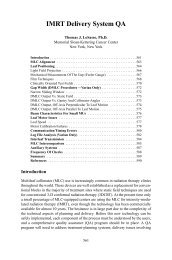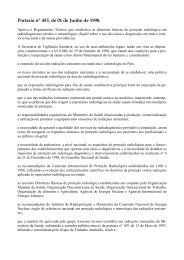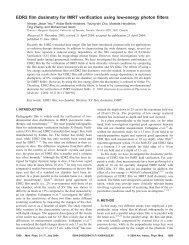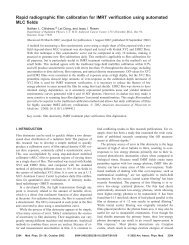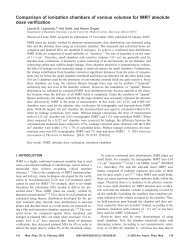intensity-modulated radiotherapy: current status and issues
intensity-modulated radiotherapy: current status and issues
intensity-modulated radiotherapy: current status and issues
Create successful ePaper yourself
Turn your PDF publications into a flip-book with our unique Google optimized e-Paper software.
IMRT: <strong>current</strong> <strong>status</strong> <strong>and</strong> <strong>issues</strong> of interest ● IMRT CWG<br />
899<br />
small as 0.5 mm. If this test is conducted with the film<br />
placed at the level of the blocking or wedge trays, a single<br />
25.4 30.5 cm 2 film may capture the entire 40 40 cm 2<br />
available field area. This film test should be repeated at the<br />
four cardinal gantry angles.<br />
Electronic portal imagers may also provide a very useful<br />
tool in the verification of DMLC or SMLC–IMRT (185,<br />
186). Using this technology, it is feasible to capture leaves<br />
at particular intervals; more importantly, an integrated composite<br />
image could also be captured.<br />
The verification of IMRT treatments represents a major<br />
challenge, <strong>and</strong> requires a shift from the conventional paradigm<br />
of weekly portal imaging. Although it is always possible<br />
to acquire an image with an adequately large portal to<br />
verify the patient’s position, it seems meaningless to acquire<br />
a portal image of every IMRT field segment, because very<br />
little anatomic information is provided. The use of the<br />
images to verify beam weight would need to de-convolve<br />
the coupled patient variation—a very difficult problem.<br />
Indeed, in the proposed helical tomotherapy system by<br />
Mackie et al. (76), dose verification will be performed by<br />
reconstructing the delivered fluence with the patient 3D CT<br />
data, acquired at the time of treatment, as prerequisite input<br />
information.<br />
In many centers that have clinically implemented IMRT,<br />
verification of machine output <strong>and</strong> patient positioning are<br />
treated as independent problems (10, 12, 187). In most<br />
instances, a pair of orthogonal open field images is acquired<br />
to verify patient setup before initiation of the delivery<br />
process. In other systems, the alignment of anatomy with<br />
the apertures of <strong>intensity</strong>-<strong>modulated</strong> fields is checked. For<br />
systems using DMLC techniques, the aperture of an <strong>intensity</strong>-<strong>modulated</strong><br />
field is defined by the terminal position of<br />
the leading leaves <strong>and</strong> the starting position of the trailing<br />
leaves. Unlike the manual placement of a Cerrobend block<br />
or a beam modifier, the computer-control technology used<br />
for IMRT delivery provides much more assurance that the<br />
radiation machine will or has performed within its specifications,<br />
thereby allowing verification of patient setup to be<br />
performed independently. It follows that the ability to acquire<br />
patient images from projections other than that of the<br />
treatment beam will allow on-line verification of the patient<br />
during treatment. Such capability will certainly alleviate<br />
some of the difficulties associated with verifying a serial<br />
tomotherapy IMRT treatment using the MIMiC system.<br />
Finally, treatment interruptions during IMRT delivery<br />
(i.e., machine failure during treatment) are a problem for<br />
most record <strong>and</strong> verification systems. Proper recovery of<br />
treatment interruptions should be tested as part of the acceptance<br />
testing <strong>and</strong> commissioning of the delivery system,<br />
<strong>and</strong> a written procedure addressing this problem must be in<br />
place.<br />
Recommendations: Acceptance testing, commissioning,<br />
<strong>and</strong> QA of IMRT systems <strong>and</strong> treatment verification<br />
The following list summarizes the recommendations regarding<br />
acceptance testing, commissioning, <strong>and</strong> QA for<br />
IMRT planning <strong>and</strong> delivery systems <strong>and</strong> treatment verification<br />
for IMRT:<br />
1. The accuracy (magnitude <strong>and</strong> position) of the IMRT<br />
dose distributions must be verified before clinical use of<br />
the IMRT system. Treatment planning companies are<br />
encouraged to implement dose-distribution measurement<br />
comparison software to enable a more thorough evaluation<br />
of the calculated dose distributions.<br />
2. The commissioning process for an IMRT planning system<br />
should include the determination of the effects of the<br />
input parameters on the optimized dose distribution. This<br />
evaluation should be conducted using clinical patient<br />
scans <strong>and</strong> tumor volumes <strong>and</strong> should be completed for<br />
each treatment site.<br />
3. The development of acceptance testing criteria <strong>and</strong> procedures<br />
for IMRT planning systems will be critical for<br />
the widespread clinical implementation of IMRT. Creating<br />
a st<strong>and</strong>ard set of phantoms with defined geometries<br />
(target volumes <strong>and</strong> critical structures) would help enable<br />
comparisons between different IMRT planning systems<br />
<strong>and</strong> develop criteria for acceptance testing <strong>and</strong><br />
commissioning.<br />
4. Dose measurements for testing IMRT systems must be<br />
conducted using non-uniform beam fluences, <strong>and</strong> the<br />
consequences of those fluences on dose measurements<br />
must be considered by the medical physicist.<br />
• Appropriate selection of detectors <strong>and</strong> the accurate<br />
determination of the detector spatial locations are critical<br />
to achieving accurate results.<br />
• The spatial relationship between the dosimeter <strong>and</strong> the<br />
phantom is required, as is the relationship between the<br />
accelerator alignment mechanism <strong>and</strong> the phantom.<br />
• The position of the calculated doses must be known.<br />
The IMRT planning system should be capable of<br />
providing the coordinates of the calculated doses.<br />
5. Commissioning should include a thorough dosimetric<br />
verification of treatment plans <strong>and</strong> prescriptions that<br />
mimic the range of the clinical target <strong>and</strong> organs-at-risk<br />
geometries anticipated to be used clinically.<br />
• The treatment plan prescriptions used for testing purposes<br />
should provide regions of high-dose gradient<br />
such that the spatial localization accuracy can be determined<br />
in all three directions.<br />
• Anthropomorphic phantoms may be useful for verifying<br />
IMRT dose distributions. Care must be taken to<br />
determine the relative location of the dosimeters <strong>and</strong><br />
external alignment marks. Geometric phantoms have<br />
the advantage that the relative location of the dosimeters<br />
<strong>and</strong> the phantom alignment marks can be determined<br />
with a high degree of accuracy.<br />
• The IMRT planning system should have the capability<br />
to apply the fluence distribution designed for one<br />
treatment plan to compute the dose to the anatomy of<br />
another plan without fluence reoptimization.




